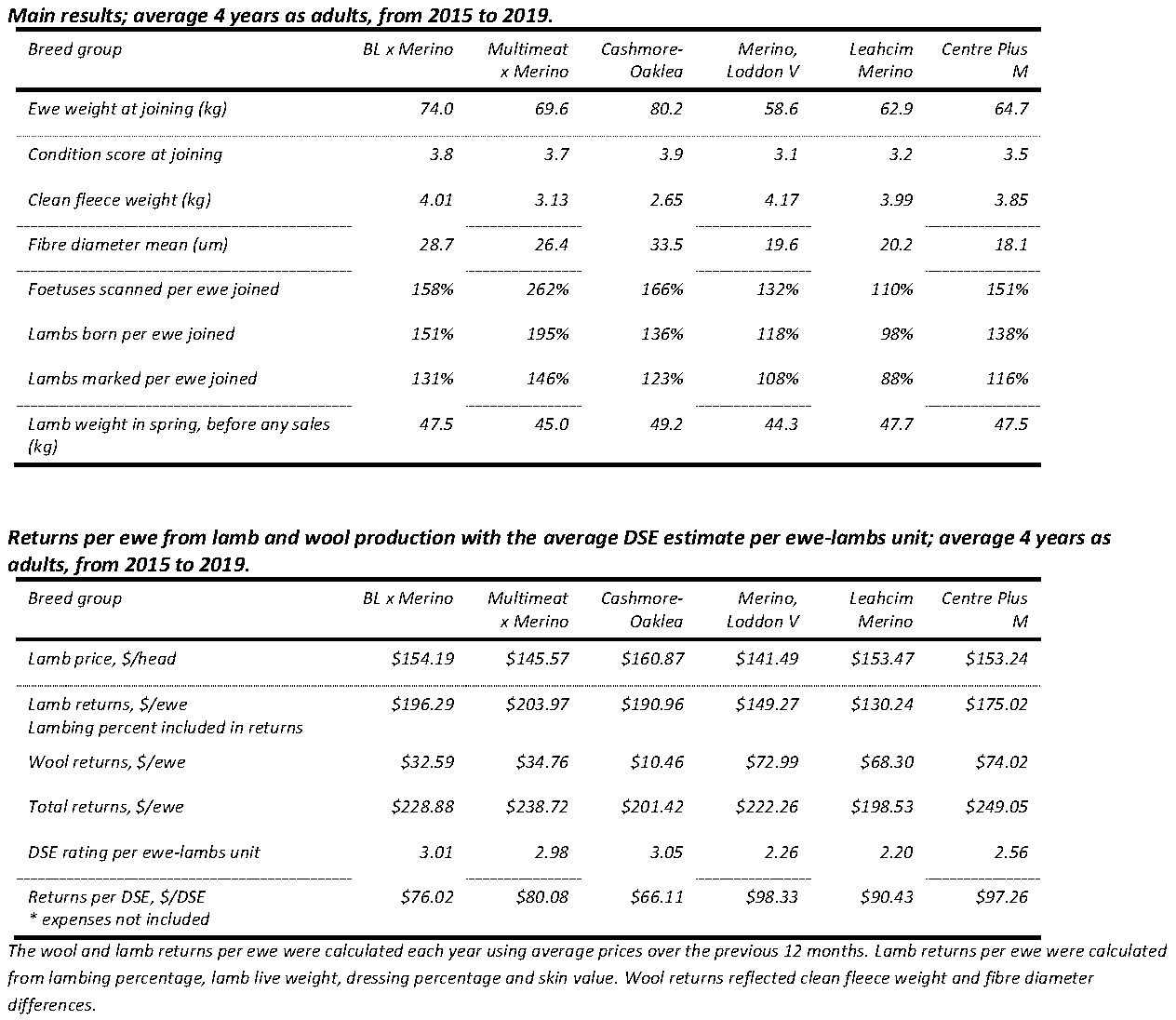Elmore Field Days - 28 June 2020
EFD EweTrial 2015-2019 FinalReport.pdf
News item from Elmore Field Days - 28 June 2020,
Contact Kieran Ransom:- kieran.ransom@bigpond.com or 0419 320 824
Elmore ‘Ewes for the Future’ study over five years – final report out
How do sheep types compare for prime lamb and for wool production? The Elmore Field Days study ‘ Ewes for the Future, fertility, lambs & wool’, has published its final report that will help sheep producers determine the merits of a number of ewe breed alternatives for prime lamb and wool production.
Key Points
- The Elmore Field Days study ‘Ewes for the Future: fertility, lambs & wool’ compared six breeds of ewes for their lifetime production of meat and wool, from 2014 to 2019.
- The main characters compared were lambing percentages, lamb growth and wool production.
- The six breed-types were each represented by 42 ewes. Each breed type group was randomly selected from three properties, with 14 ewe lambs per property after an allowance for culling.
- The final results indicate large differences in gross meat and wool returns between ewe types.
- The results are most relevant in the mixed sheep and cropping areas on northern Victoria and southern New South Wales. Elmore is a healthy environment for merino sheep with few worm and feet problems.
In the study six breed types of ewes were joined to terminal sires, either White Suffolk or Poll Dorset for five years; their first joining was as ewe lambs. The ewe breed types were:
- Border Leicester x Merino cross ewes. The most common prime lamb mother in the Elmore and northern districts.
- Multimeat x Merino cross ewes. These ewes carry the Booroola gene for higher lambing percentages. Multimeat breeders claim these ewes consistently rear 30% more lambs than normal crossbreds.
- Cashmore-Oaklea Performance Maternals (Composites). They have achieved a reputation for good lambing percentages that are assisted by the hybrid vigour between the various breeds.
- Merino Loddon Valley, locally bred Merinos sourced from Loddon Valley Merino ram breeders. The second most common prime lamb mother in the Elmore and northern districts.
- Leahcim Merinos, a South Australian Merino stud that has a long history of selecting for a specialty dual purpose merino with low wrinkle and high quality wool.
- Centre Plus Merino is a group breeding scheme and Merino stud in Central West NSW that aims to produce multipurpose sheep.
Results
The ewes were run together as one mob except at lambing. The results presented in the tables only cover the four adult years. The first year joining as ewe lambs occurred only seven weeks after their arrival on the Elmore Field Days farm and their body weights and age were the main reasons for the breed differences. Lambing percentages, lamb growth, and wool are all highly relevant to improving profitability, but no single ewe type exceled in all compartments.
Prime lambs from the specialist dual purpose merinoewes - Leahcim and Centre Plus; reached the same market weight as lambs from the Border Leicester x Merino ewes on the date of the first lamb sale. They were also only 1.6 kg lighter than the lambs from the Composite ewes.
The three Merino types had the greatest wool returns whereas the crossbreds had the greatest lamb returns, see table. When wool and meat were combined, the differences between the crossbreds and merinos were, on average, quite close. However, average returns of merinos or crossbreds per ewe are a gross simplification; there are differences within the two types. Feed intake differences must also be taken into account as higher numbers of lambs reared and heavier ewes need more feed. However indications are that dual purpose Merinos with good wool, reproduction and lamb growth are likely to be the most profitable alternative in this Elmore environment. Northern Victoria is highly suited to merino sheep; there were no worm or feet problems at Elmore; the results may be different in wetter climates more suited to cross bred types. Whole flock systems analyses using models such as GrassGro are needed to fully investigate whole farm profitability.
Most sheep in Australia are seasonal breeders. They join more readily in the autumn that late spring to early summer. The breeds in this trial differ in their seasonality of breeding. Border Leicester x Merino (BL x M ) cross ewes are well known to be more seasonal breeders than merinos. The Cashmore – Oaklea Performance Maternals would also be expected to be more seasonal breeders due to their background that includes Border Leicesters, Coopworths and Romneys.
This study was not designed to compare the seasonality of breeding season between the ewe groups. Lambing percentages are influenced by many factors including ewe condition score, live weight, nutrition around joining time, nutrition 4 to 6 months before joining as well as the seasonality of the breeding season.
More information
The full results are available from kieran.ransom@bigpond.com or the Elmore Field Days. The 36 page report gives the full details.
This project was funded and conducted by the Elmore Field Days Inc. together with The Campaspe Prime Lamb Producers Group with professional help from three organisations and six product support sponsors.

- Log in to post comments



